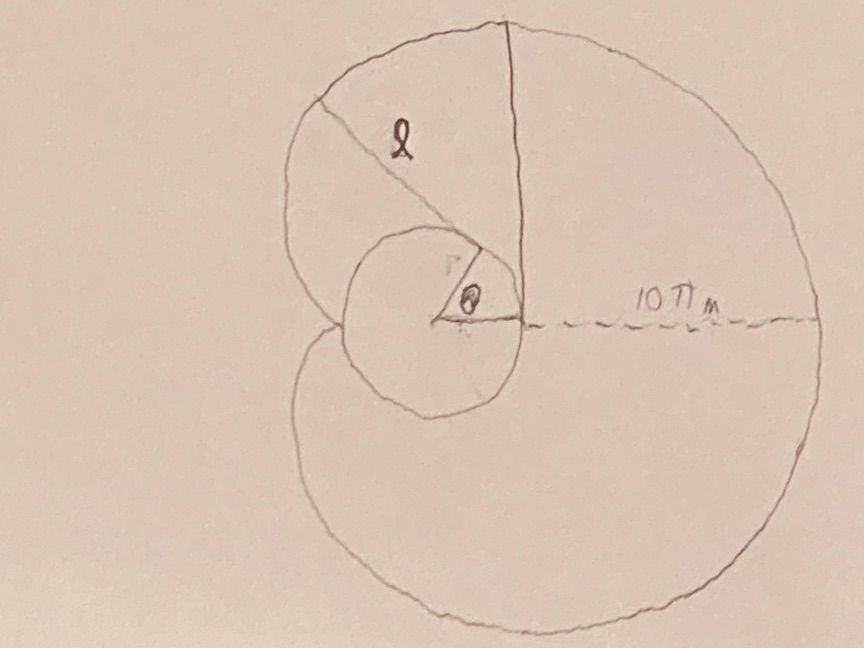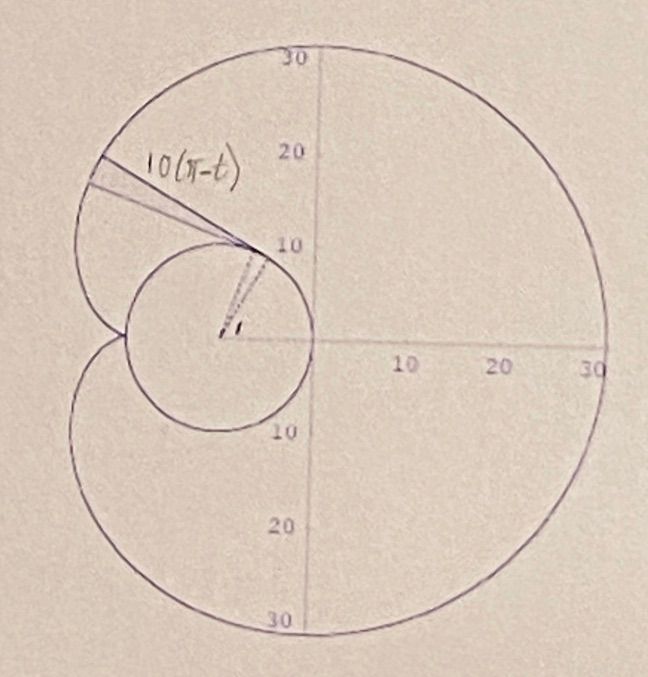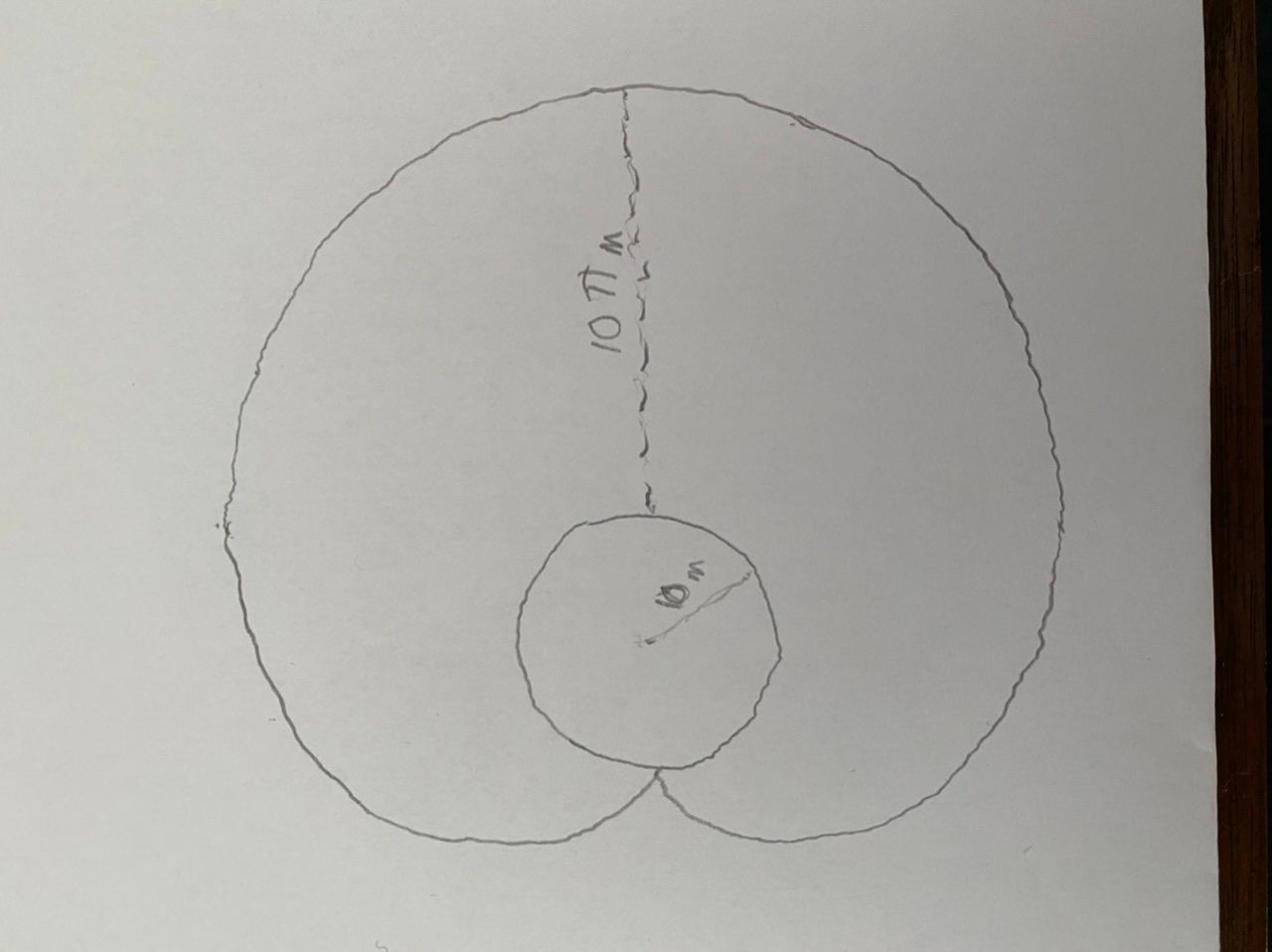Puzzle time - Silo dog
-
I figure the dog wanting to mark its territory simply pees all over the place.
-
Game plan would be:
-
Find function that computes max height/distance from any point on silo, i.e., the shape of the "wrap around" part.
-
Presuming the formula is complicated, ask computer algebra system to integrate the function to find its area.
-
Multiply by two and add area of the semi-circle.
-
-
I glad he didn’t say the three of you
-
||Cycloid is key.
Imagine the silo "rolls over" by 180º, the arc traced out by the point opposite the hook is that of a cycloid, and the area under the cycloid is given by the formula 3πr^2 where r is the silo's radius.
Solution is (area of cycloid traced out by the silo)-(area of silo)+(half the area of circle with radius that is the leash's length).
Area covered by the dog = 3π(10)^2 - π(10)^2 + (π(10π)^2)/2
|| -
||Cycloid is key.
Imagine the silo "rolls over" by 180º, the arc traced out by the point opposite the hook is that of a cycloid, and the area under the cycloid is given by the formula 3πr^2 where r is the silo's radius.
Solution is (area of cycloid traced out by the silo)-(area of silo)+(half the area of circle with radius that is the leash's length).
Area covered by the dog = 3π(10)^2 - π(10)^2 + (π(10π)^2)/2
||@Axtremus said in Puzzle time - Silo dog:
Imagine the silo "rolls over" by 180º, the arc traced out by the point opposite the hook is that of a cycloid,
But how does that arc relate to where the dog can go? Your solution - which may well be correct - is missing an argument here.
-
That's ugly don't continue.
Smallish hint:
||Look at the cardioid area in isolation and write an equation for the length of the leash as a function of the angle traversed through it.||
Biggish hint:
||Imagine the dog is at the "northern" border between the half circle and the cardioid part as shown in this diagram:

His leash is now a tangent on the circle formed by the silo.
As he moves "west" the leash shortens but continues drawing a tangent against the circle. As a first step, express the length 𝓁 of the leash as a function of the angle θ.||
-
Here it is, in a spoiler in case someone still wants to solve it.
||As previously noted, the total area comprises a half circle plus that little strange part which apparently is called a cardioid (a word I don't remember hearing before this thread.
The half circle is easy, 1/2(pi * r^2), where the radius is 10pi, so 50pi^3.
Now for the cardioid area. Note in the following diagram, when stretched taut the length of the remaining leash after it has already wrapped around a portion of the silo wall is the total length of the leash minus the circumference of the arc it has traversed. So if we call the angle t the length is 10pi - 10t, or 10(pi-t).

Now for a little calculus. Increase t by a tiny amount - dt. The tangent advances correspondingly, and the area of the tiny sector of the circle you've covered is 50(pi-t)^2 dt. Integrate that from 0 to pi and you get 50/3 * pi^3.
Double that to get 100/3 * pi^3 and add the half circle and the final answer is 250/3 * pi^3.||
-
Sorry, I was too lazy to continue.
Could you tell me where the 50(pi-t)^2 dt comes from?
Also, it is not obvious to me that the integral gives you the area. The ordinary (Riemann) integral computes the limit of the area of a sequence of boxes, like so:

But you are filling the area with sectors of circles. It's not obvious to me that the methods of Riemann integration work in that setting. I'm not saying it's wrong; I'm saying it's not obviously correct.


